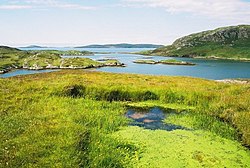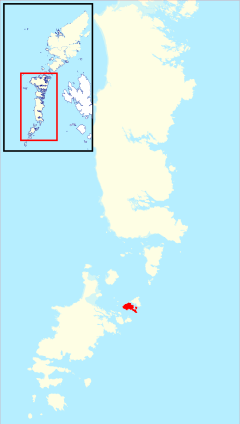Hellisay: Difference between revisions
Created page with "{{Infobox island |name=Hellisay |gaelic=Theiliseigh |norse name= |county=Inverness |picture=Sound of Gighay - geograph.org.uk - 648155.jpg |picture caption=The Sound of Gighay..." |
No edit summary |
||
| Line 5: | Line 5: | ||
|county=Inverness | |county=Inverness | ||
|picture=Sound of Gighay - geograph.org.uk - 648155.jpg | |picture=Sound of Gighay - geograph.org.uk - 648155.jpg | ||
|picture caption=The Sound of Gighay | |picture caption=The Sound of Gighay from Càrais on Hellisay | ||
|os grid ref=NF756040 | |os grid ref=NF756040 | ||
|latitude=57.01 | |latitude=57.01 | ||
Latest revision as of 20:04, 21 March 2020
| Hellisay Gaelic: Theiliseigh | |
 The Sound of Gighay from Càrais on Hellisay | |
|---|---|
| Location | |
| Location: | 57°-0’36"N, 7°21’-0"W |
| Grid reference: | NF756040 |
| Area: | 351 acres |
| Highest point: | Meall Meadhonach, 259 feet |
| Data | |
| Population: | 0 |
Hellisay is a currently uninhabited small island, one of ten islands in the Sound of Barra which lies between Barra and South Uist in the Outer Hebrides and within Inverness-shire. The narrow Sound of Gighay lies between Hellisay and its neighbouring island, Gighay.
Its name is from the Norse for 'Cave Island'.
Geography and geology

Hellisay lies in the Sound of Barra, one of a string of small islands in that sound. It lies close to its neighbour Gighay, with a narrow channel, the Sound of Gighay, between.
The bedrock is mainly gneiss with quartz veins.[1]
There are several peaks on the island including Beinn a' Chàrnain in the west ('mountain of the small cairn'; 240 feet), Meall Meadhonach ('middle rounded hill'; 259 feet) and Meall Mòr ('Great rounded hill', which stands east of Meall Meadhonach and south of the peninsula of Càrais; 249 feet).
Wildlife
Along with a variety of seabirds, raptors including falcons and golden eagles have been seen on Hellisay.[1] The island has a profusion of sea thrift[1] and the Sound of Gighay has been described as a "quiet secret place of wild irises and marshmallows".[2]
History
The island's name is Old Norse in origin. It possibly means "island of the caves", which appears to be confirmed by the name Rubha na h-Uamh (headland of the cave) in the east of the island. However, Blaeu's map has "Hildesay", which suggests that the name may derive from the Norse for "Hilda's Island".[1]

The island's settlement was at Buaile Mhòr (anglicised to Bualavore and meaning "the big fold") near Eilean a' Ghamhna in the north-west of the island. The remains of a sheep pen and a well can still be seen.
Like so many other islands in the region, Hellisay's community was destroyed in the Highland Clearances. Firstly, refugees from clearances in neighbouring islands swelled the population, and latterly the island's inhabitants themselves were evicted, and many went to live on Eriskay. The population peaked at 108 in 1841, and the island was cleared in the 1840s - however it continued to have some inhabitants up until 1890.[1]
Alasdair Alpin MacGregor's stories reveal a rich folklore and mythology extant on the island, possibly only a fraction of which has been preserved.[1]
In Media
Franciscan priest, specialist in mystical theology and author Rayner Torrington wrote a book describing how he was influenced by meeting a hermit called Peter Calvay who lived on Hellisay for a number of years in the first half of the twentieth century. [3] The book titled ‘Peter Calvay, hermit: A personal rediscovery of prayer’ was first published in 1977 and has had at least eleven reprintings. Torkington’s book ‘Wisdom from the Western Isles: the making of a mystic’, published in 2008, also describes the author’s meetings with Peter Calvay whilst the author was staying on the nearby island of Barra. [4]
| ("Wikimedia Commons" has material about Hellisay) |
References
- ↑ 1.0 1.1 1.2 1.3 1.4 1.5 Haswell-Smith, Hamish (2004). The Scottish Islands. Edinburgh: Canongate. ISBN 1841954543.
- ↑ "Best of Scotland's islands". (9 August 2013) Highland News. Retrieved 16 October 2013.
- ↑ Rayner Torkington (1991). Peter Calvay, Hermit: A Personal Rediscovery of Prayer. Mercier. ISBN 978-0-85342-969-2. https://books.google.com/books?id=3rzjAAAACAAJ.
- ↑ David Torkington (30 January 2015). Wisdom from the Western Isles: The Making of a Mystic. John Hunt Publishing. ISBN 978-1-78535-017-7. https://books.google.com/books?id=Mp9SBgAAQBAJ.
- Haswell-Smith, Hamish (2004). The Scottish Islands. Edinburgh: Canongate. ISBN 1841954543.
| The islands of the Sound of Barra, Inverness-shire | ||
|---|---|---|
|
Calvay • Eriskay • Fiaraidh • Flodday • Fuday • Fuiay • Gighay • Hellisay • Lingay • Orosay |
Barra | |

